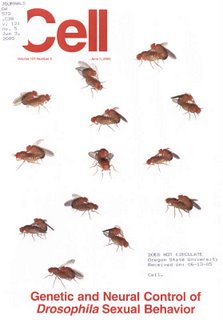 PHOTO: OSU student Tess Jarmain escorts four male-oriented (homosexual) rams in Oregon State University's flock back to pasture. Photo by Tiffany Brown from 'The science of rams and sexuality: Not all seek ewes,' By Mary Ann Albright, Corvallis (Oregon) Gazette-Times, August 12, 2005 (See previous posts OSU student recruits volunteers by pitching gay sheep research (2/12/15) and OSU Gay Sheep NY Times (2/7/07))
PHOTO: OSU student Tess Jarmain escorts four male-oriented (homosexual) rams in Oregon State University's flock back to pasture. Photo by Tiffany Brown from 'The science of rams and sexuality: Not all seek ewes,' By Mary Ann Albright, Corvallis (Oregon) Gazette-Times, August 12, 2005 (See previous posts OSU student recruits volunteers by pitching gay sheep research (2/12/15) and OSU Gay Sheep NY Times (2/7/07))
 PHOTO: Cover of the journal Cell June 3, 2005 showing gay fruit flies having sex. (See previous posts Marc Breedlove seeks donations for gay science documentary (8/4/12) and OSU gay fruit fly sex research (9/16/06))
PHOTO: Cover of the journal Cell June 3, 2005 showing gay fruit flies having sex. (See previous posts Marc Breedlove seeks donations for gay science documentary (8/4/12) and OSU gay fruit fly sex research (9/16/06))
In the latest print edition of "The Advocate" that is apparently not yet available online printed an interesting essay by brenden shucart, "What's the use of being gay?" Advocate, Oct./Nov. 2015, p. 23 (apparently available only in print edition as of Sep. 15, 2015). (For more on the author, see Brenden Shucart (born 1981) wikipedia.org accessed Sep. 15, 2015)
Shucart doesn't mention directly the scientific debate between biological essentialists and social constructionists, but he does reference some of the latest scientific discoveries concerning the genetics of homosexuality and then asks how it ties in the evolutionary theories of the past:
" . . . Others questioned whether homosexuality had a genetic component and even (gasp!) evolutionary benefits. . . In 2004 an Italian research team led by Andrea Camperio-Ciani postulated that homosexuality could be explained through Richard Dawkins' theory of "sexually antagonistic selection" wherein a set of genes might increase the procreational competitiveness of one gender while dimiising the other's changes. . . .
This year a study was published with the Royal Society that applied sexually antagonistic selection theories to the lives of fruit flies . . . found an undeniable link between same-sex behavior in male fruit flies and an increase in the fecundity of females from the same line. . . study doesn't examine the potential benefits of homosexuality. . .
Shucart also discusses other theories of why homosexuality exists in nature, such as the idea that it is a population limiting mechanism in evolution, which he cites one source that questions this theory, and his favorite theory that "envisions the gay man as bridge builder and peacemaker."
In my opinion, a more interesting question to me is how the concept of social constructions be modeled mathematically in a way that could be simulated on a computer so that different variables could be adjusted and multiple simulations be run to see what would happen over time. For example, a very simplistic model has always said that if 100 percent of people are gay, then the chance humans will reproduce is diminished and humans could go extinct. I suspect that such modeling would find that a few percent of the population being gay is the optimal level to achieve some of the positive benefits hypothesized by shucart, while simultaneously minimizing the negatives, such as the reduction in breeding efficiency, etc.
P.S. A note to the designer of the new Advocate. com Website after I was unable to find this essay on the site, even using Google search and your own search box -- yes, it appears that Advoate.com has had a much needed graphic design update from the original HTML Website that has existed for almost two decades, and it appears that the new Advocate.com has better integrated the modern features of mobile interfaces and social networking, but I was unable to find any articles or text like I could easily do on the old site. Perhaps some of the problem is the obnoxious pop-up ads that Microsoft's default software warns is trying to install adware -- yes, I appreciate you have to monetize with advertising, but you need to do advertising in a way that doesn't drive readers away from the site in fear! Yes, I am legally blind, which makes it harder for me to appreciate your new design, but compared to other sites with similar functionality, Advocate.com seems to be causing me more trouble than these other sites and so I believe the problem is in more in your design than my own poor eyesight.